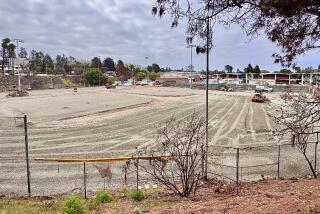Alternatives to Belmont Site Have Problems of Their Own
- Share via
Having scuttled the Belmont Learning Complex, Los Angeles school officials now face an immense challenge in fulfilling their promise to quickly replace the 5,000 seats the high school would have provided.
Chief Operating Officer Howard Miller has named four potential high school sites, and interim Supt. Ramon C. Cortines has proposed using commercial high-rises to open new schools quickly.
But those alternatives have defects that could cause long delays or prove insurmountable. Most of the proposed sites are smaller than that being abandoned. Some have environmental problems far worse than the seeping methane and hydrogen sulfide that plague the Belmont project. Others are tangled in negotiations that could end up in court or require complex relocations.
The school board on Tuesday voted 5 to 2 to abandon the $200-million Belmont complex. Those who fought to the last to save it say they have little reason to believe that the district will come through on a decade-old promise to offer their neighborhood a modern, fully equipped high school.
“They are in denial,” said Gloria Soto, president of the community advisory council at the existing Belmont, a small and aging campus crammed with 4,600 students. “If there was another place, we would have been the first to say, ‘Let’s go over there.’ ”
Soto’s neighborhood west of downtown is forced to bus thousands of students of all ages to schools throughout the district; 2,000 high school students ride the buses every day.
Miller’s favored alternative is the former Ambassador Hotel in the mid-Wilshire district, a choice that would be drenched in irony. More than 10 years ago, the Board of Education picked the Ambassador for a high school site but dropped it amid a court battle with real estate magnate Donald Trump, who had wanted to put the world’s tallest building there.
After a long legal battle with Trump and his successors, the district is expected to gain possession of the property through foreclosure. However, the district is negotiating with Magic Johnson’s development firm and Councilman Nate Holden to combine a middle school with a cinema. Holden opposes a senior high as incompatible with commercial use.
On top of that, the Los Angeles Conservancy is prepared to go to court to block the current district plan, which would demolish the hotel. The Ambassador was the site of early Oscar nights and Robert F. Kennedy’s assassination.
School board member Caprice Young said she believes that the district can compromise but expects Holden, Johnson and the conservancy to also consider the desperate needs of children.
“It’s time they started thinking about kids,” Young said.
The other prospects for a high school are the former train yard north of Chinatown, and the Terminal Annex post office and the district headquarters, both on the north edge of downtown.
The former train yard, known as the Cornfield, offers space to match the 35 acres of the abandoned Belmont site but may be the most environmentally suspect because of decades of train traffic.
Past district studies have found it unsuitable for schools, and several board members said they think it their least likely choice.
Terminal Annex has other potential suitors, including the Art Center College of Design in Pasadena. It also has drawbacks mentioned in a preliminary study for the district by consultant URS Grenier Woodward Clyde. The study found nine underground storage tanks and, more seriously, concluded that a high potential for contamination remains from uses on or near the site that include wood staining and gluing, steel forging and vehicle storage.
Its worst feature, though, may be its neighbor, the Twin Towers jail, raising the specter of students mingling with criminals.
“You do your time at County [Jail], and you’re out on the street,” said Gabriel Monares, deputy to school board member Victoria Castro, the Belmont project’s only staunch supporter.
As another alternative, Miller has said he hopes to convert district headquarters into an arts academy connected to the nearby Music Center. The property is surrounded by busy highways and would not accommodate nearly the number of students or the athletic facilities of the abandoned Belmont site a few blocks away.
And it would not be available until the district found a much larger facility to consolidate the administrative offices with business employees now housed in a high-rise.
Even Cortines’ short-term plan to create classrooms in commercial buildings could run afoul of state laws that put extra burdens on schools to ensure safety against hazards such as fire and earthquake.
Given the drawbacks to the alternatives, board member David Tokofsky said he believes that the solution may be numerous smaller high schools.
Young said she too expects more than one alternative because she doesn’t want to build schools for more than 2,000 students.
She is confident that the obstacles can be overcome, because the district now has a solid management team in place.
“We have learned from the mistakes of Belmont, so we’ll be able to do it right this time,” Young said.
More to Read
Sign up for Essential California
The most important California stories and recommendations in your inbox every morning.
You may occasionally receive promotional content from the Los Angeles Times.














